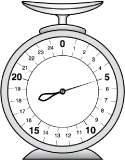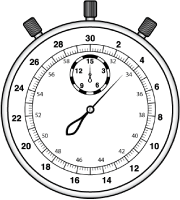Measurement Activities & Exercises
Keeping Track of Measurement
Over a 24-hour period, keep a running record of all the different times you encounter measurement in any form. Include measurement of time, money, length, weight, volume, speed, temperature, and any other attributes that you notice. Try to come up with a longer list of examples than anyone else in your study group. Try to come up with the most unusual unit of measurement. Don't forget about constructed units that refer to a relationship between units (miles per hour, for example). Compare your list with your colleagues' lists.
Measure It!
Exactly how long is this lock?
-
Exactly how much does the object on this scale weigh?
Is a heart-shaped measuring cup accurate? Can you think of any good reasons NOT to use one of these in your teaching? If you do use one, how can you convince children of its accuracy?
What do the markings on the face of this stopwatch measure? If the large dial measures half-minutes each time it goes around, what do you think the small dial measures? Can you be sure without seeing the watch in operation?
If a digital stopwatch gives readouts of hundredths-of-a-second, does that indicate that it is giving exact measurements of elapsed time?














